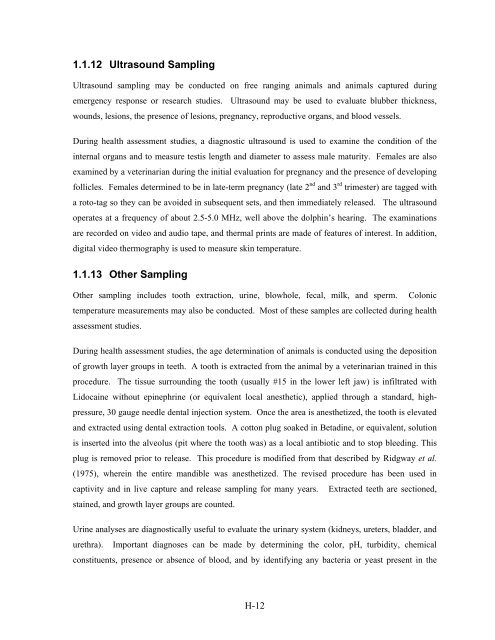Volume III, Appendices EM - National Marine Fisheries Service ...
Volume III, Appendices EM - National Marine Fisheries Service ...
Volume III, Appendices EM - National Marine Fisheries Service ...
Create successful ePaper yourself
Turn your PDF publications into a flip-book with our unique Google optimized e-Paper software.
1.1.12 Ultrasound Sampling<br />
Ultrasound sampling may be conducted on free ranging animals and animals captured during<br />
emergency response or research studies. Ultrasound may be used to evaluate blubber thickness,<br />
wounds, lesions, the presence of lesions, pregnancy, reproductive organs, and blood vessels.<br />
During health assessment studies, a diagnostic ultrasound is used to examine the condition of the<br />
internal organs and to measure testis length and diameter to assess male maturity. Females are also<br />
examined by a veterinarian during the initial evaluation for pregnancy and the presence of developing<br />
follicles. Females determined to be in late-term pregnancy (late 2 nd and 3 rd trimester) are tagged with<br />
a roto-tag so they can be avoided in subsequent sets, and then immediately released. The ultrasound<br />
operates at a frequency of about 2.5-5.0 MHz, well above the dolphin’s hearing. The examinations<br />
are recorded on video and audio tape, and thermal prints are made of features of interest. In addition,<br />
digital video thermography is used to measure skin temperature.<br />
1.1.13 Other Sampling<br />
Other sampling includes tooth extraction, urine, blowhole, fecal, milk, and sperm. Colonic<br />
temperature measurements may also be conducted. Most of these samples are collected during health<br />
assessment studies.<br />
During health assessment studies, the age determination of animals is conducted using the deposition<br />
of growth layer groups in teeth. A tooth is extracted from the animal by a veterinarian trained in this<br />
procedure. The tissue surrounding the tooth (usually #15 in the lower left jaw) is infiltrated with<br />
Lidocaine without epinephrine (or equivalent local anesthetic), applied through a standard, highpressure,<br />
30 gauge needle dental injection system. Once the area is anesthetized, the tooth is elevated<br />
and extracted using dental extraction tools. A cotton plug soaked in Betadine, or equivalent, solution<br />
is inserted into the alveolus (pit where the tooth was) as a local antibiotic and to stop bleeding. This<br />
plug is removed prior to release. This procedure is modified from that described by Ridgway et al.<br />
(1975), wherein the entire mandible was anesthetized. The revised procedure has been used in<br />
captivity and in live capture and release sampling for many years. Extracted teeth are sectioned,<br />
stained, and growth layer groups are counted.<br />
Urine analyses are diagnostically useful to evaluate the urinary system (kidneys, ureters, bladder, and<br />
urethra). Important diagnoses can be made by determining the color, pH, turbidity, chemical<br />
constituents, presence or absence of blood, and by identifying any bacteria or yeast present in the<br />
H-12
















